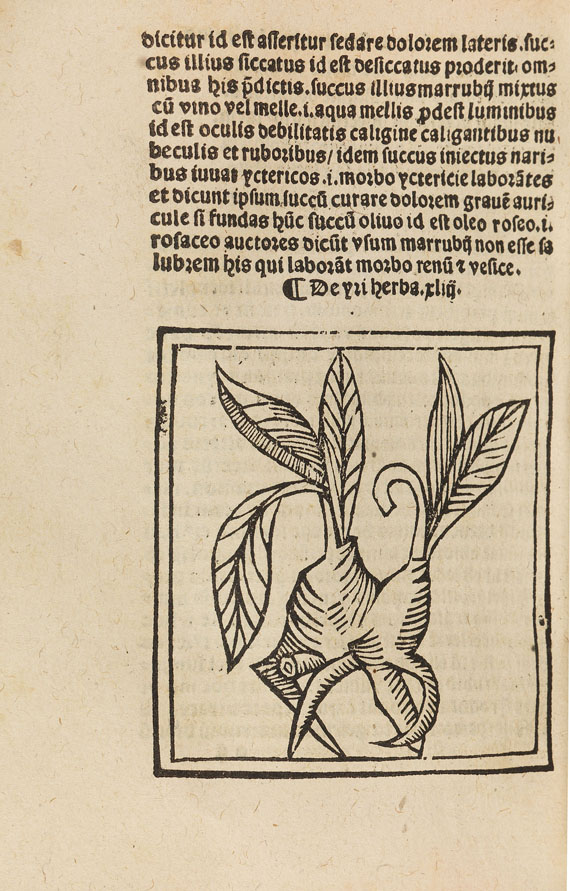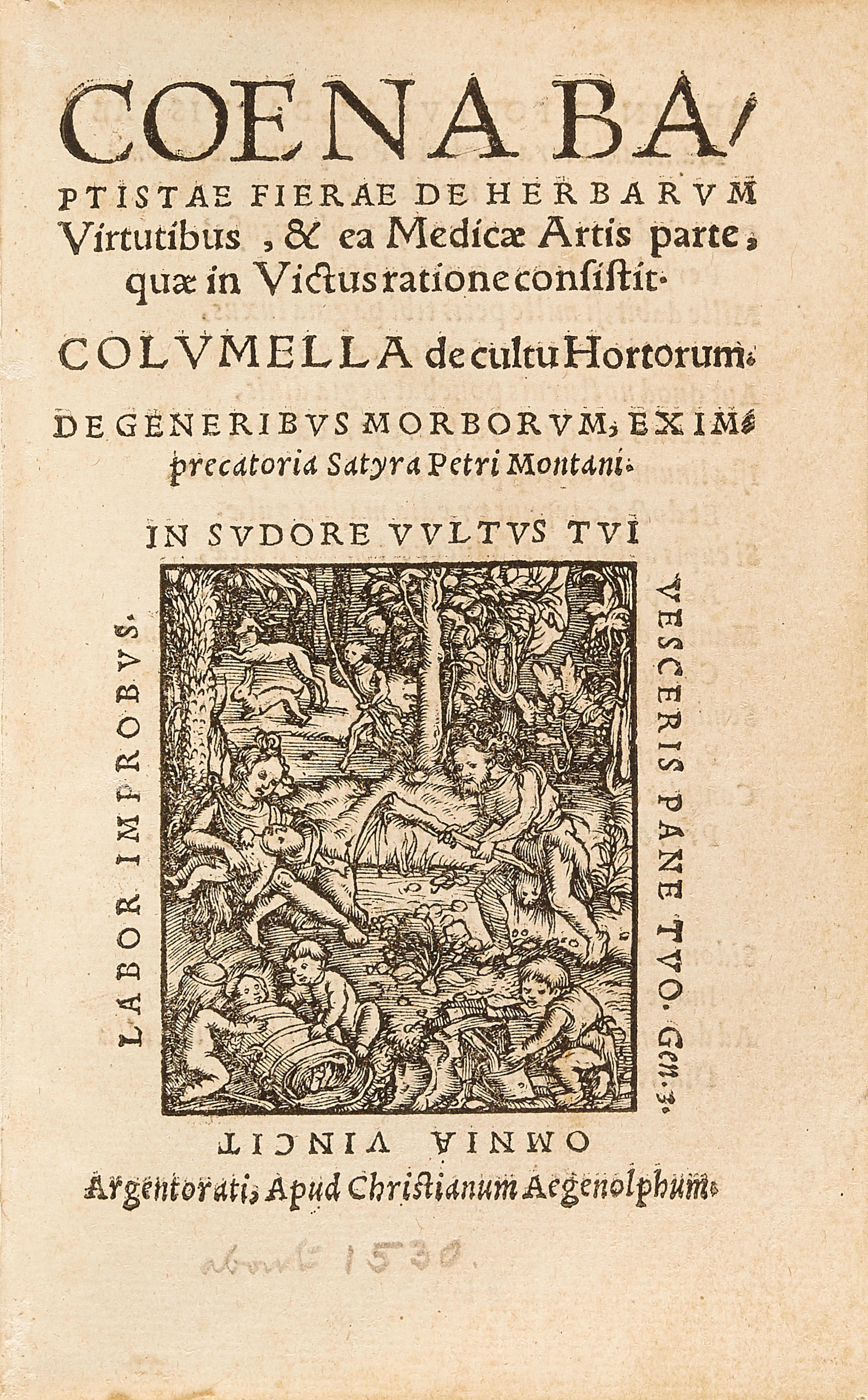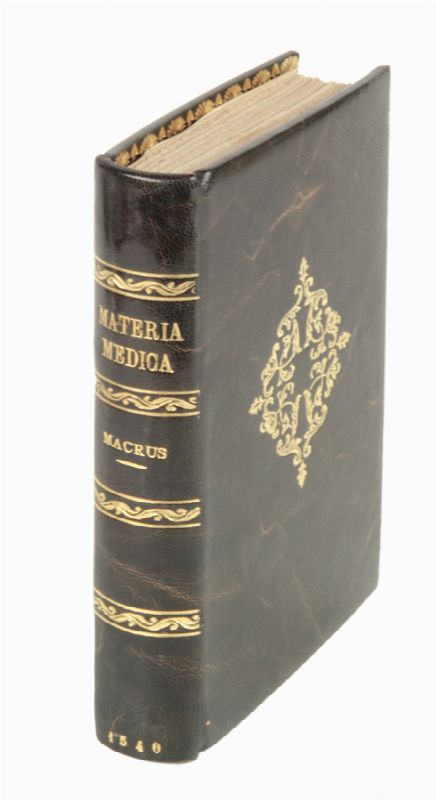MACER FLORIDUS, DE VIRIBUS HERBARUM, in Latin, Herbal attributed to Odo de Meung, MANUSCRIPT ON VELLUM [Germany, last quarter of the 12th century] 200 x 125mm, 22 leaves, collation: 1 10 2 12 . Written in a late Caroline minuscule, the second quire in a different hand and from another manuscript. Quire 1: 29 lines, in brown ink in a fine regular hand, headings in red, capitals partly stroked in red, 2- and 3- line decorated initials in red introducing each verse, height of written space 155mm. With numerous 14th-century marginal annotations. Quire 2: Written in a more inferior minuscule, palimpsest on an earlier double column medical text visible under ultraviolet light. Original page height 175mm, but with later extension at foot, 29-33 lines, in brown ink, headings in red, 2-line red initials introducing each verse. Height of written space approx. 145mm. First and last leaf of second quire imperfect (with loss of portion of 10 lines on folio 11, and approximately 28 lines on folio 22). Fine 6-line initial 'H' of strapwork design in red and blue on first folio. Antique-style binding of wooden boards with calf back and endpapers from a 15th-century manuscript. TEXT: Odo de Meung flourished about the end of the 11th century in the Loire area of France. He wrote his herbal in verse. His poem is not based on original observation, but nevertheless important, as one of the earliest Western documents demonstrating the revival of interest in botany in the middle ages. Much of the text is based on Pliny and Greek botanists, but the work was nevertheless very influential and extensively used in the celebrated Regimen Sanitatis of Salerno. Although quite a number of manuscripts are known, this is one of the earliest that we have been able to trace. Choulant in his edition lists only two 13th century manuscripts. De Ricci's Census describes 7 manuscripts in America, including the Pierpont Morgan Library (mid-12th century) and New York Academy of Medicine and Yale Medical Library (both 13th century). Unfortunately the text of the present manuscript is incomplete. It contains only 1245 lines, of a total of 2269; and 41 descriptions of flowers and herbs (of 77). Four of these are incomplete (Rosa, Iris, Berbena) and one that we have been unable to identify. One headed 'Sempviva' in the manuscript, actually forms part of 'Acidula'. Much of the text is based on Pliny and other Greek authors. LITERATURE: L.Choulant, ed. Macer Floridus de viribus herbarum . Leipzig 1832. G.Sarton, Introduction to the History of Science . Vol.I. 1927, pp765-6
MACER FLORIDUS, DE VIRIBUS HERBARUM, in Latin, Herbal attributed to Odo de Meung, MANUSCRIPT ON VELLUM [Germany, last quarter of the 12th century] 200 x 125mm, 22 leaves, collation: 1 10 2 12 . Written in a late Caroline minuscule, the second quire in a different hand and from another manuscript. Quire 1: 29 lines, in brown ink in a fine regular hand, headings in red, capitals partly stroked in red, 2- and 3- line decorated initials in red introducing each verse, height of written space 155mm. With numerous 14th-century marginal annotations. Quire 2: Written in a more inferior minuscule, palimpsest on an earlier double column medical text visible under ultraviolet light. Original page height 175mm, but with later extension at foot, 29-33 lines, in brown ink, headings in red, 2-line red initials introducing each verse. Height of written space approx. 145mm. First and last leaf of second quire imperfect (with loss of portion of 10 lines on folio 11, and approximately 28 lines on folio 22). Fine 6-line initial 'H' of strapwork design in red and blue on first folio. Antique-style binding of wooden boards with calf back and endpapers from a 15th-century manuscript. TEXT: Odo de Meung flourished about the end of the 11th century in the Loire area of France. He wrote his herbal in verse. His poem is not based on original observation, but nevertheless important, as one of the earliest Western documents demonstrating the revival of interest in botany in the middle ages. Much of the text is based on Pliny and Greek botanists, but the work was nevertheless very influential and extensively used in the celebrated Regimen Sanitatis of Salerno. Although quite a number of manuscripts are known, this is one of the earliest that we have been able to trace. Choulant in his edition lists only two 13th century manuscripts. De Ricci's Census describes 7 manuscripts in America, including the Pierpont Morgan Library (mid-12th century) and New York Academy of Medicine and Yale Medical Library (both 13th century). Unfortunately the text of the present manuscript is incomplete. It contains only 1245 lines, of a total of 2269; and 41 descriptions of flowers and herbs (of 77). Four of these are incomplete (Rosa, Iris, Berbena) and one that we have been unable to identify. One headed 'Sempviva' in the manuscript, actually forms part of 'Acidula'. Much of the text is based on Pliny and other Greek authors. LITERATURE: L.Choulant, ed. Macer Floridus de viribus herbarum . Leipzig 1832. G.Sarton, Introduction to the History of Science . Vol.I. 1927, pp765-6












.jpg)
Try LotSearch and its premium features for 7 days - without any costs!
Be notified automatically about new items in upcoming auctions.
Create an alert